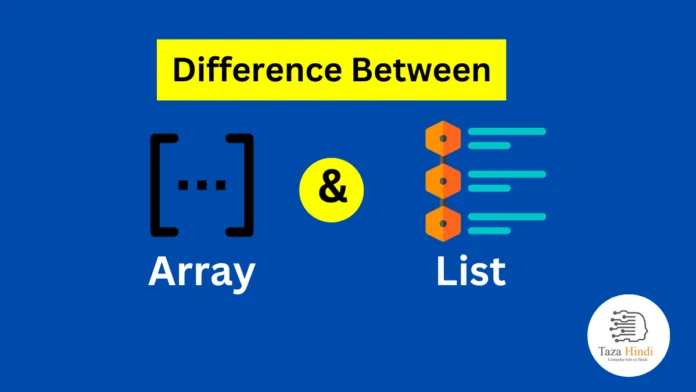When it comes to data storage and manipulation, two commonly used data structures are arrays and lists. Both serve the purpose of holding multiple elements, but they differ in several aspects. In this tutorial, you will get information definition of Array and List, storage mechanisms, advantages, disadvantages and uses of arrays and lists. By the end, you will have a clear understanding of the difference between Array and List.
Definition of Arrays
Arrays are a fixed-size collection of elements that are stored in contiguous memory locations. Each element in an array is accessed using an index value, starting from 0. Arrays can hold elements of the same data type, making them useful for organizing homogeneous data.
How Arrays Store elements?
When an array is created, a block of memory is allocated to hold the specified number of elements. Elements are stored sequentially in this block, and their positions are determined by their respective indices.
Uses of Arrays
Arrays are widely used in various programming languages due to their simplicity and efficiency. They provide quick access to elements based on their index and are particularly suitable for tasks that involve sorting, searching, and random access operations.
Fixed size and contiguous memory allocation of arrays
One of the key characteristics of arrays is their fixed size. Once an array is created, its size cannot be changed dynamically. This limitation can be problematic when dealing with situations where the number of elements may vary. Additionally, arrays require contiguous memory allocation, meaning that the entire block of memory must be available in a single location.
Also Read : Difference between Compiler and Assembler
Disadvantages of Arrays
The fixed size of arrays poses challenges when the number of elements is unknown or subject to change. Resizing an array often requires creating a new array with a different size and copying the existing elements, which can be time-consuming and resource-intensive. Moreover, the requirement of contiguous memory can limit the maximum size of an array.
What is Lists?
A list is a dynamic-size collection of elements that can store data of different types. Unlike arrays, lists do not require a fixed size upon creation and can grow or shrink as needed. Lists are implemented using linked data structures, where each element (node) contains a value and a reference to the next node.
Characteristics of Lists
Lists have several notable characteristics. They can store elements of different data types, making them more versatile than arrays. Lists also provide flexibility in terms of size, as they can be dynamically resized to accommodate changes in the number of elements. This dynamic nature allows for efficient memory utilization.
How lists store elements of any data type?
In a linked list, each node contains a value and a reference to the next node. This arrangement allows elements to be stored non-contiguously in memory, eliminating the need for contiguous memory allocation. Each node points to the next node in the list, forming a chain.
Also Read : Difference between Recursion and iteration
What is Dynamic size and linked data structure of lists?
Unlike arrays, lists do not have a fixed size. Elements can be easily added or removed from a list without the need for extensive memory reallocation. This dynamic nature makes lists suitable for situations where the number of elements is unpredictable or subject to frequent changes. The linked data structure allows for efficient insertion and deletion operations, as only the affected nodes need to be modified.
Overview of List operations
Lists support various operations, including adding elements at the beginning or end of the list, inserting elements at specific positions, removing elements, and accessing elements by index. These operations are optimized for dynamic resizing and maintain the integrity of the linked structure.
Uses of Lists
Lists find applications in scenarios where flexibility and ease of manipulation are paramount. They are commonly used in data structures such as stacks, queues, and graphs. Lists are also favored for tasks that involve frequent insertions and deletions, as they offer efficient time complexity for these operations.
Benefits of Lists
The dynamic nature and linked data structure of lists provide several advantages over arrays.
- Lists can accommodate varying numbers of elements, making them suitable for situations where the size of the data is uncertain. This flexibility helps optimize memory usage by allocating memory only as needed.
- The linked structure of lists allows for efficient insertion and deletion operations. Unlike arrays, which require shifting elements when inserting or removing, lists only require modifying the references between nodes. This results in faster and more efficient operations, particularly when dealing with large data sets.
- Lists can store elements of different data types, providing versatility in handling heterogeneous data. This feature is particularly useful in scenarios where different types of information need to be organized and accessed together.
Also Read : Difference between Constructor and Method
Difference between Array and List
Although arrays and lists share the purpose of storing multiple elements, they differ significantly in several aspects:
| Array | List |
| Arrays have a fixed size determined upon creation | Lists can dynamically grow or shrink as elements are added or removed. |
| Arrays require contiguous memory allocation, meaning the entire block of memory must be available in a single location. | Lists, on the other hand, use a linked data structure, allowing non-contiguous memory allocation. |
| Arrays store elements of the same data type, ensuring homogeneity. | Lists can hold elements of different data types, enabling heterogeneity. |
| Inserting or deleting elements in arrays often requires shifting subsequent elements, resulting in slower operations for large arrays. | Lists, with their linked structure, offer efficient insertion and deletion by modifying references between nodes. |
| Arrays provide direct access to elements based on their index, allowing for constant-time retrieval. | Lists require sequential traversal to access elements, resulting in linear-time complexity for accessing specific elements. |
| Arrays may require more memory than lists due to their fixed size, potentially resulting in wasted memory. | Lists optimize memory usage by dynamically allocating memory only as needed. |
Also Read : Why Algorithm is important in programming
Conclusion
Arrays and lists are both valuable data structures with distinct characteristics and use cases. Arrays excel in scenarios where a fixed-size, homogeneous collection of elements is required, offering efficient random access operations. On the other hand, lists provide flexibility, dynamic resizing, and support for heterogeneous data, making them ideal for situations where the number of elements varies or where efficient insertion and deletion operations are essential.
Understanding the differences between arrays and lists empowers developers to choose the appropriate data structure based on the specific requirements of their projects. By leveraging the strengths of arrays and lists, programmers can optimize memory usage, improve performance, and enhance the overall functionality of their applications.
FAQs
-
Can arrays hold elements of different data types?
No, arrays can only store elements of the same data type. If different data types need to be stored, a list should be used instead.
-
Can the size of an array be changed dynamically?
No, the size of an array is fixed upon creation and cannot be changed. To accommodate more elements, a new array with a different size must be created.
-
Which data structure is more efficient for insertion and deletion operations?
Lists are more efficient for insertion and deletion operations due to their linked structure, which requires modifying references rather than shifting elements.
-
Are lists suitable for random access operations?
No, lists require sequential traversal to access specific elements, resulting in linear-time complexity. Arrays provide constant-time retrieval based on index.
-
Can lists be used for homogeneous data storage?
Yes, lists can store elements of the same data type. However, their ability to handle heterogeneous data sets is a distinct advantage over arrays.



